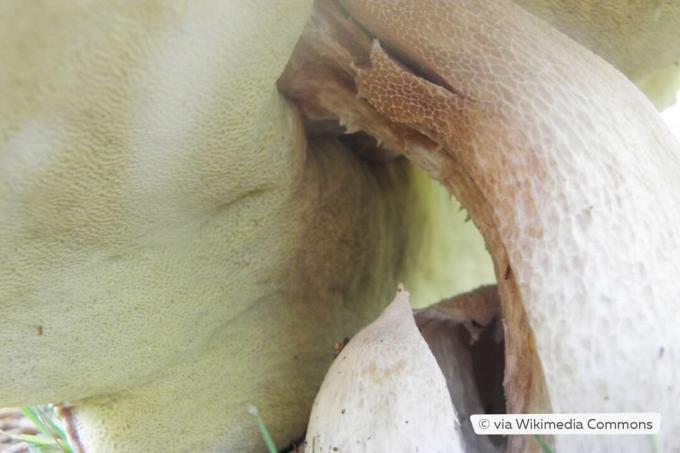
There are several porcini mushrooms native to Germany, many with brown caps, but few with yellow sponges. However, the tubes in all species turn yellowish-green with age.
In a nutshell
- Porcini mushrooms can be distinguished from other types of mushrooms by a few features
- There is a risk of confusion, especially if you are careless
- rare appendage boletus lone boletus with always yellow tubes
- is under nature protection
Table of contents
- General characteristics of porcini mushrooms
- Various types of porcini mushrooms
- The appendage boletus
- confusion
- frequently asked Questions
General characteristics of porcini mushrooms
All types of porcini have some common characteristics that distinguish them from other mushrooms:
- comparatively thick stems and large caps
- Cuticle dull, mostly dry, sometimes moist or somewhat sticky, never slimy or greasy
- Hat color mostly light to dark brown
- Stems lighter, with or without reticulation
- always grows in connection with different tree species (symbiotic fungus)
- Taste and odor mild or mushroomy
- Flesh not or only slightly discolouring
- Tubes easily detachable, light when young, yellow to olive when old

Source: Rob Hille, Boletus edulis R.H. (4), Edited from Plantopedia, CC BY-SA 3.0
As a result, each porcini mushroom can have yellowish tubes as it ages, and it is difficult to identify the species from the sponge. It will be easier if the location of the fungus is observed and the time at which it grows.
Various types of porcini mushrooms

Source: Wilhelm Zimmerling PAR, Ruhland, Ortrander Str., sports field, boletus under oak trees, top and side view, autumn, 01, Edited from Plantopedia, CC BY-SA 4.0
- Spruce boletus (Boletus edulis): from July to November, under spruce trees
- Summer porcini (Boletus reticulatus): May to September, under oak trees
- Pine porcini (Boletus pinophilus): July to October, under pines, rarely under spruces
The appendage boletus
The only fungus that belongs to the porcini family and always has a yellow sponge is the appendage boletus (Butyriboletus appendiculatus), also known as yellow porcini. How to recognize him:

You can contact this user here.
English | espanol | french | italiano | macedonian | മലയാളം | portuguese | +/−, 2009-11-13 Boletus appendiculatus Schaeff 401116, Edited from Plantopedia, CC BY-SA 3.0
- Cap up to 20 cm wide, different brown colors, often copper, bronze or ocher, finely felted
- Stem light, yellowish, with eponymous appendage in the bottom
- Sponge yellowish, older more olive-colored
- Flesh yellow, bluing on pressure like the tubes
- Occurs from June to October in deciduous forest, under oak or beech, on calcareous soil
- only in warmer regions
- overall rather rare
- Smell and taste mild, slightly mushroomy or sour
A notice: The appendage boletus is so rare that it is specially protected and may not be collected.
confusion
Porcini mushrooms can be confused with some other mushrooms unless careful attention is paid to their characteristics. real risk of confusion however, only exists with the inedible bile boletus, since the other doubles are edible:

Source: Jerzy Opioła, Tylopilus felleus BW 47, Edited from Plantopedia, CC BY-SA 4.0
- Chestnut boletus (Xerocomus badius): usually slender stalk, fruit body smaller overall, flesh and tubes turn blue when pressured or cut, hat tends to be greasy when wet; good edible mushroom
- Bile boletus (Tylopilus felleus): the main feature is the bitter taste, if in doubt try a small taste (be sure to spit it out again!), cap usually light, tubes white at first, later pink
- Coniferous appendage boletus (Butyriboletus subappendiculatus): only in coniferous forest, flesh discolors only slightly; edible but protected
A notice: In rare cases, bile boletes can also taste mild and are then even more difficult to distinguish from porcini mushrooms.
frequently asked Questions
The tubes only need to be removed when the mushrooms are older. Or if there is a suspicion that the hat over the tubes might be maggots. Otherwise the tubes can be eaten. When the mushrooms are marinated, the sponge soaks up the marinade and becomes particularly tasty. The same applies to mushrooms that are preserved in oil.
There aren't very many mushrooms with tubes that are poisonous. These include: Boletus boletus (Boletus calopus), Satan's boletus (Rubroboletus satanas) and the wolf boletus (Rubroboletus lupinus), which is at least suspected of being poisonous. All of these mushrooms differ from the porcini mushroom in that they have red tubes or a reddish stalk.
All mushrooms can only be collected in small quantities. In addition, some very rare species are specially protected and may not be allowed to be collected at all in some areas. Some types of porcini mushrooms belong to these mushrooms. It makes sense to find out in advance whether mushrooms can be collected without hesitation.
